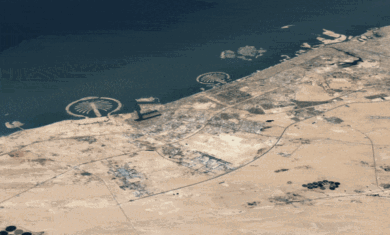I’ve long felt that two things would need to happen to get to the next level in 3D imagery — trees and highway overpasses.
Since one of the neat features in Google Earth is the ability to fly a route, having proper overpasses would make things look much better. The latest version of Virtual Earth has some cities modeled in “version 2.0”, which include a number of advances. To the right is a bridge over a river. While the bottom is still solid (you can’t see the river under the bridge) and the edges are rough, it’s really coming along nicely. The tighter mesh of elevation data is getting us closer to where I’d like to see it. I would think we’ll see some real progress in this area within the next year or so.
The bigger problem is the lack of trees. Amazingly, Microsoft has begun to fix that already, too! I really felt that was still well off in the future, but I’m glad I was wrong. It only works in their “version 2.0” cities (Las Vegas, Dallas, Denver and Phoenix), but it’s really neat. As Google Earth Blog had speculated, the trees are generated automatically by Microsoft. Hand-placing thousands of trees would be an impossible task to keep up with.
 In addition, the trees don’t affect load time very much. They only have to load a given tree type once, then tweak the height and diameter for each placement of it. As such, I’ve found the trees load very quickly — usually before most of the buildings.
In addition, the trees don’t affect load time very much. They only have to load a given tree type once, then tweak the height and diameter for each placement of it. As such, I’ve found the trees load very quickly — usually before most of the buildings.
I’m a bit concerned about performance, though. The tree models look excellent, and with thousands of them scattered around a city, I have to think that it’ll make things move a little slower. I’m currently out of town on an old laptop, so everything is slow right now. When I get home to my primary PC I’ll really start putting it through it’s paces.
Microsoft says that the updated data will roll out to the current set of 250 3D cities “soon” and I’m really looking forward to it.

